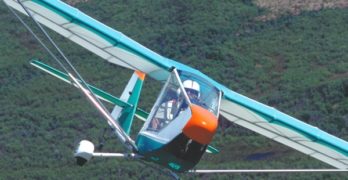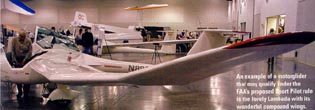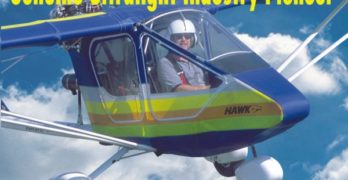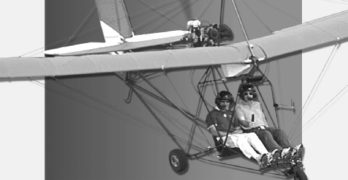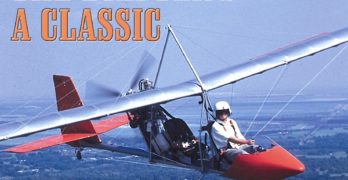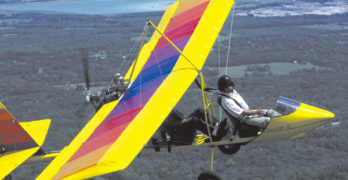Given Chuck Slusarczyk’s decades in recreational aviation, I imagine almost everyone in ultralight aviation has heard of the funny, Polish-speaking pioneer with the hard-to-pronounce last name (Slew-Sar-Chick). If Chuck had named his first business Slusarczyk Glider Supplies, pilots would have stumbled and renamed it for him. Knowing his name is a tongue twister, he wisely called it Chuck’s Glider Supplies.
In his early business years, when Chuck was younger and slimmer, he made hang gliders. Lots and lots of hang gliders. I flew one, as did thousands of others. He was one of a handful of east-of-the-Mississippi hang glider manufacturers. Being a long way from the West Coast where hang gliding was centered back in the ’70s, Chuck made the Californians nervous. They couldn’t keep an eye on his developments and he was regarded as unpredictable. Those who knew him thought the word should be innovative.
Then came powered hang gliding, such as it was in those days.
Search Results for : Icon
Not finding exactly what you expected? Try our advanced search option.
Select a manufacturer to go straight to all our content about that manufacturer.
Select an aircraft model to go straight to all our content about that model.
Product Lines – August 1996
ST. PAUL, MINN — Airshow season is here. About the same time we hang glider pilots are heading out to sites across the country to catch the big thermals of summer, millions of non-pilots (and pilots) will attend local-area airshows. They’re America’s second largest public spectator event after baseball, quite a statement in a country known around the globe for having countless choices of entertainment. At how many of those airshows will the millions see hang gliding? Darn few! ••• One man is changing that by succeeding as few before him have done. Dan Buchanan performs despite physical challenges (a vehicle accident if you don’t know Dan’s story). He was able to fly the main airshow at Oshkosh last year, no small feat since the Wisconsin convention is one of the world’s largest events with close to a million people attending. Some pilots have waited literally years to get in, that is, to volunteer to perform; no pay is offered.
Product Lines – February 2003
St. Paul, Minn. — Please bear with me as I use all of this month’s column on something that has little to do with products, the usual focus of this column. I’ve been doing this bit of writing for Hang Gliding magazine for a long time (“PL” finishes 24 years with this issue), but one man has been even more long lived. lll After 25 years on the job, Hang Gliding editor Gil Dodgen handed off all his duties to Dan Nelson, a new paraglider pilot with an editorial background. Gil started with USHGA’s magazine with the January, 1978 issue. For those with weak memories or those too new to hang gliding to know the past, an extremely brief history lesson is in order. s In 1978, the Big Three of hang glider building in the USA were Seagull, Electra Flyer, and Wills Wing. We had other prominent Yankee brands like Sky Sports, Bennett Delta Wing, Eipper-Formance, Ultralite Products, Manta, Sunbird, Highster, and CGS Aircraft.
Product Lines – April 00
ST. PAUL, MINN., — Late-breaking news includes the 2000 U.S. Nationals now being slated for Lakeview July 16-22. GW Meadows, the contest organizer, broke the news which was then confirmed from several sources. More news as it unfolds. Info: 252-480-3552. ••• It’s spring in America and all spotlights are turned on Florida where meets at Wallaby and Quest dominate the buzz. ••• Of late, reading Davis Straub’s Oz Report — which dwells heavily on competition — makes some enthusiasts wonder if Moyes sponsors the webzine (they don’t). The Lightspeed’s contest prowess has filled many online paragraphs. However, recent news of the Mexican Millennium Cup revealed Laminar started off 2000 well. Though neither was the winner, in both Mexican and earlier Australian Bogong Cup competitions we saw strong finishes by Wills’ Fusion and Aeros’ Stealth. Huh! Here in the new millennia, if one ignores rigid wings (sure!, just try), all we seem to hear about are Moyes, Icaro, Wills, Aeros (in no particular order, thank you).
Product Lines – January 04
ST. PAUL, MINN. — Happy New Year, glider fans. Once again a new year brings wintertime
chills, at least for us northerners. So, this month I have some warm-up ideas
to get you in the mood for a new soaring season.
Mexican Flying Tours are in full swing for HGs and PGs. Cold weather flyers take
note of temperatures in the 80s with plentiful thermals and authentic Mexican food.
One outfit calls the experience a “Mextravaganza.”
Super Fly Paragliding Mexico Tours 2004 treks to the famous Valle de Bravo
site in central Mexico. At it for eight years, Super Fly takes you to fly three sites
in seven days during January and February. PG gurus Jeffrey Farrell and Chris
Santacroce are leading two tours in January and one in early February for pilots
with P2 ratings or better and a minimum of 50 flight hours.
They’ll handle the language, pickup and delivery from Mexico City airport, offer
5-star lodging in “a new, secure, classy, and clean hotel,” local club memberships,
XC retreival in air conditioned vehicles, and in-flight coaching by radio.
AirSports Expo 2002
AirSports Expo attracts a large crowd and many vendors.
On the first day in Ontario, California, you could see this was going to be the largest AirSports Expo yet. In the shadow still lingering from September 11, many wondered and worried about participation and attendance, but the concern was baseless. A flurry of activity in the last few weeks before the show brought so many requests for exhibit space that the already designed floor plan had to be scrapped and redrawn.
More than 2200 pilots and other visitors saw the exhibits of 65 vendors. While still small next to Sun ’n Fun or AirVenture Oshkosh, this was a good turnout. The range of vendors included many aircraft suppliers and all manner of accessories and informational products.
Gathering of Eagles
AirSports Expo represents the combined efforts of the Soaring Society of America (SSA), the U.S. Ultralight Association (USUA), and the U.S. Hang Gliding Association (USHGA).
Hawk (at 20 years)
The nation is focused on the celebration of 100 years of powered flight, thanks to efforts by a couple of Ohio brothers in 1903. But ultralight aviation has its own bigger-than-life hero from yesteryear and he’s also from Ohio.
Chuck Slusarczyk needs no introduction because almost everyone involved with ultralight aviation for any length of time knows the jolly designer of the Hawk series of ultralights.
Chuck first flew gliders just as did Orville and Wilbur Wright. Like the famous Wrights, he ignored those who said he couldn’t do what he hoped to do – in Chuck’s case, bring to market an ultralight that broke new ground in several important ways. For one, you had no chance to foot-launch it.For those who became ultralight enthusiasts more recently, the rule in the early 1980s – before passage of FAR Part 103 – was that ultralights had to be foot-launchable. When Slusarczyk first introduced the Hawk, a demonstration of foot-launching was required; since the Hawk was fully enclosed, the pilot could not provide the demonstration, if asked.
Quicksilver’s Sport II
You’ve heard it before: Quicksilver is back! Again and again we’ve heard this, yet it seemed to be an apparition, a mirage in the desert. As soon as you thought the company had put its financial affairs in order, along came another disappointing tale of what was politely called “corporate restructuring.”
In fact, the changes were often more provocative than substantial, but they gave the impression of a company that had lost its way. The worst thing that happened was that customers became unsure if they should send deposit money.
This was not a good place to be in the ultralight industry. Companies work hard to establish good reputations. They know those good vibes can disappear as quickly as a wing nut in tall grass.
The 1999 reincarnation of the company is called Quicksilver Manufacturing. Previously, the company had been called Quicksilver Enterprises and Quicksilver Aircraft (and before that a series of Eipper iterations, named after founder Dick Eipper).
Super Drifter
The original Drifter was one of the ultralight industry’s flagship aircraft. Hatched by early entrepreneur Dennis Franklin, the Maxair Drifter enjoyed immense popularity. Several reasons exist for the Drifter’s popularity, and these were enough for Leza-Lockwood to offer a rebirth to the design.
Déjà Vu All Over Again
The Drifter is a tough design. The basic airframe consists of a lower boom tube that supports the pilot at the front and the large empennage at the rear with an engine midship. Because the separation is longer than some similar designs, the Drifter boasts a high level of stability that should please most pilots.
Secured to the boom by a series of triangulated tubing structures, the wing is classic Klaus Hill. This prolific designer from the early ’80s died in an unfortunate accident many years ago, but not before putting his indelible mark all over ultralight aviation. Klaus is directly responsible for the wings of the Weedhopper, Hummer, Humbug and SuperFloater.
Super Drifter XL with Rotax 912
Considered by many to be a workhorse, the Super Drifter XL shows refinement and features that make it seem like a “luxury ultralight.” Leza AirCam, the newly renamed producer of this venerable ultralight, has equipped the top-of-the-line model with nearly every option in their price list. Conclusion: While it will cost you a bundle, you should be satisfied with this ultralight for many years.
How is this Super Drifter XL different from the Super Drifter that I evaluated almost 3 years ago? According to Denny Franklin – yes, that same icon of the Maxair days when the Drifter was a youngster – the XL is a significant redesign of the original Super Drifter 912 flown in 1998.1 It has seen numerous changes to make the veteran design work better with the big 80-hp Rotax 912 situated at the rear of the wing.
What’s New With the Super Drifter XL?
The Super Drifter XL has an extended fuselage – meaning the boom tube and its fuselage “pan” – to position the front seat 5 inches further forward.
- « Previous Page
- 1
- …
- 26
- 27
- 28


